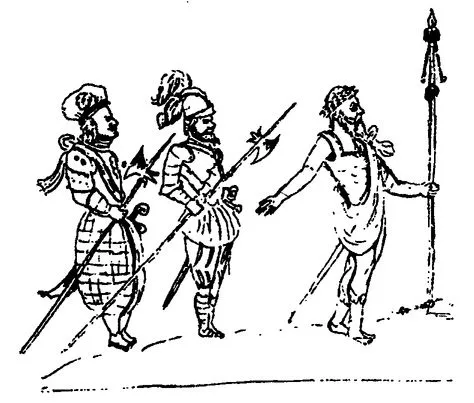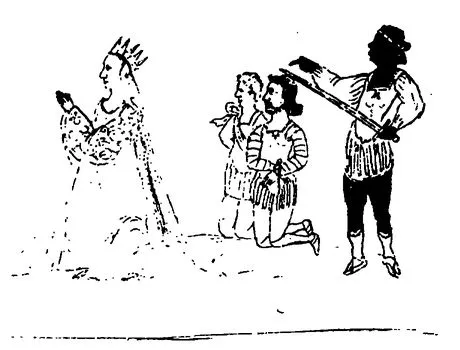We have already discussed some kinds of spectacle in the preceding section, and now we will begin with other aspects of visual language; a theater, after all, is literally a “place for seeing.” Consider the opening stage direction in The Tempest, the first play in the first published collection of Shakespeare’s plays: “A tempestuous noise of thunder and Lightning heard: Enter a Shipmaster, and a Boteswain. ”
Costumes: What did that shipmaster and that boatswain wear? Doubtless they wore something that identified them as men of the sea. Not much is known about the costumes that Elizabethan actors wore, but at least three points are clear: (1) many of the costumes were splendid versions of contemporary Elizabethan dress; (2) some attempts were made to approximate the dress of certain occupations and of antique or exotic characters such as Romans, Turks, and Jews; (3) some costumes indicated that the wearer was supernatural. Evidence for elaborate Elizabethan clothing can be found in the plays themselves and in contemporary comments about the “sumptuous” players who wore the discarded clothing of noblemen, as well as in account books that itemize such things as “a scarlet cloak with two broad gold laces, with gold buttons down the sides.”
The attempts at approximation of the dress of certain occupations and nationalities also can be documented from the plays themselves, and it derives additional confirmation from a drawing of the first scene of Shakespeare’s Titus Andronicus—the only extant Elizabethan picture of an identifiable episode in a play. (See pp. xxxviii-xxxix.) The drawing, probably done in 1594 or 1595, shows Queen Tamora pleading for mercy. She wears a somewhat medieval-looking robe and a crown; Titus wears a toga and a wreath, but two soldiers behind him wear costumes fairly close to Elizabethan dress. We do not know, however, if the drawing represents an actual stage production in the public theater, or perhaps a private production, or maybe only a reader’s visualization of an episode. Further, there is some conflicting evidence: In Julius Caesar a reference is made to Caesar’s doublet (a close-fitting jacket), which, if taken literally, suggests that even the protagonist did not wear Roman clothing; and certainly the lesser characters, who are said to wear hats, did not wear Roman garb.


It should be mentioned, too, that even ordinary clothing can be symbolic: Hamlet’s “inky cloak,” for example, sets him apart from the brightly dressed members of Claudius’s court and symbolizes his mourning; the fresh clothes that are put on King Lear partly symbolize his return to sanity. Consider, too, the removal of disguises near the end of some plays. For instance, Rosalind in As You Like It and Portia and Nerissa in The Merchant of Venice remove their male attire, thus again becoming fully themselves.
Gestures and Silences: Gestures are an important part of a dramatist’s language. King Lear kneels before his daughter Cordelia for a benediction (4.7.57-59), an act of humility that contrasts with his earlier speeches banishing her and that contrasts also with a comparable gesture, his ironic kneeling before Regan (2.4.153-55). Northumberland’s failure to kneel before King Richard II (3.3.71-72) speaks volumes. As for silences, consider a moment in Coriolanus: Before the protagonist yields to his mother’s entreaties (5.3.182), there is this stage direction: “Holds her by the hand, silent. ” Another example of “speech in dumbness” occurs in Macbeth, when Macduff learns that his wife and children have been murdered. He is silent at first, as Malcolm’s speech indicates: “What, man! Ne‘er pull your hat upon your brows. Give sorrow words” (4.3.208-09). (For a discussion of such moments, see Philip C. McGuire’s Speechless Dialect: Shakespeare’s Open Silences [1985].)
Of course when we think of Shakespeare’s work, we think primarily of his language, both the poetry and the prose.
Prose: Although two of his plays (Richard II and King John) have no prose at all, about half the others have at least one quarter of the dialogue in prose, and some have notably more: 1 Henry IV and 2 Henry IV, about half; As You Like It and Twelfth Night, a little more than half; Much Ado About Nothing, more than three quarters; and The Merry Wives of Windsor, a little more than five sixths. We should remember that despite Molière’s joke about M. Jourdain, who was amazed to learn that he spoke prose, most of us do not speak prose. Rather, we normally utter repetitive, shapeless, and often ungrammatical torrents; prose is something very different—a sort of literary imitation of speech at its most coherent.
Today we may think of prose as “natural” for drama; or even if we think that poetry is appropriate for high tragedy we may still think that prose is the right medium for comedy. Greek, Roman, and early English comedies, however, were written in verse. In fact, prose was not generally considered a literary medium in England until the late fifteenth century; Chaucer tells even his bawdy stories in verse. By the end of the 1580s, however, prose had established itself on the English comic stage. In tragedy, Marlowe made some use of prose, not simply in the speeches of clownish servants but even in the speech of a tragic hero, Doctor Faustus. Still, before Shakespeare, prose normally was used in the theater only for special circumstances: (1) letters and proclamations, to set them off from the poetic dialogue; (2) mad characters, to indicate that normal thinking has become disordered; and (3) low comedy, or speeches uttered by clowns even when they are not being comic. Shakespeare made use of these conventions, but he also went far beyond them. Sometimes he begins a scene in prose and then shifts into verse as the emotion is heightened; or conversely, he may shift from verse to prose when a speaker is lowering the emotional level, as when Brutus speaks in the Forum.
Shakespeare’s prose usually is not prosaic. Hamlet’s prose includes not only small talk with Rosencrantz and Guildenstern but also princely reflections on “What a piece of work is a man” (2.2.312).
1 comment